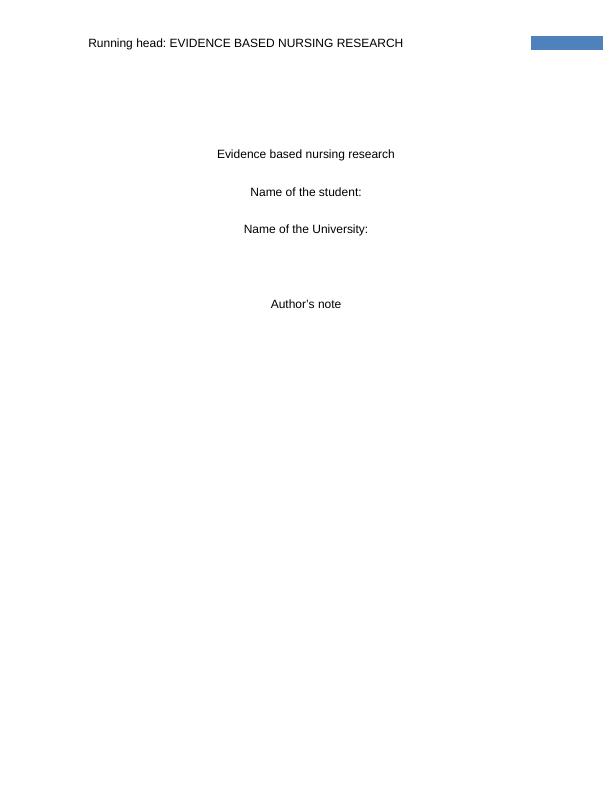Ask a question from expert
Evidence Based Nursing - Assignment
12 Pages2907 Words163 Views
Added on 2020-05-11
Evidence Based Nursing - Assignment
Added on 2020-05-11
BookmarkShareRelated Documents
Running head: EVIDENCE BASED NURSING RESEARCHEvidence based nursing researchName of the student:Name of the University:Author’s note

1EVIDENCE BASED NURSING RESEARCHIntroduction:The report provides a critique of a qualitative research article by Broadbent, Moxham & Dwyer, (2014) to find out the best practice available to address the environmental challenges and challenges faced by staffs in attending to client with mental illness. The research article is published in the Australasian Emergency Nursing Journal which is an official journal of the College of Emergency Nursing Australia. The main advantage that college members and others subscribers get from this journal is that it provides high quality and thought provoking knowledge related emergency nursing practice in Australia, New Zealand and overseas. The impact factor of the journal is high as its accepts original research work and double-blind peer review process is used to enhance the quality and trustworthiness of the evidence (Australasian Emergency Nursing Journal, 2017). In addition, the credibility of the article is also understood from the research interest and professional background of the researchers. Dr. Marc Broadbent’s main research interest is emergency care, management of vulnerable people in the emergency department (Dr Marc Broadbent, 2017).Secondly, Lorna Moxham is a professor of Mental Health nursing with research interest in the same field and Trudy Dwyer has research interest in rapid response system and clinical teaching (Dwyer, 2017).With years of experience in their professional field and publication of past research work, it is confirmed that the researchwould offer high quality of data for ED nursing. Name: Student number: | 1

2EVIDENCE BASED NURSING RESEARCHBackground/aimBroadbent, Moxham & Dwyer, (2014) used ethnographic research design to investigate about the challenges associated with working in a triage environment and identifying about the impact of triage practice environment on the role of triage nurse in conducting triage assessment in clients coming to mental illness in emergency department (ED). The reason for such research is understood from the case scenario that maximum client with mental illness attend ED first to access care and lack of appropriate triage environment affect patient safety and privacy. The motivation for the research on this topic is also understood from the problem statement in the research article that flow of clients with mental illness to the Australian ED has increased due to mainstreaming of mental health service into general health service (Shafiei, Gaynor, & Farrell, 2011). Although the Australian government has responded to this issue by introducing specialist mental health triage scales and specialist mental health clinicians within ED, the research emphasized that management of such patients remains the core responsibility of triage nurse (Ebrahimi et al., 2016). Hence, as there is lack of evidence regarding the impact of triage environment on triage assessment process done by nurse, this research became important. The review of literature related to the topics has also helped Broadbent, Moxham& Dwyer, (2014) to engage in decision making and plan research design. For example, literature review of recent research work mainly discussed about the ED design in Australia and the provision needed in ED triage design according to the policy documents in Australia (Ebrahimi et al., 2016). Research evidence regarding use of space in ED and mental health setting was also found (Nugus & Forero, 2011).Name: Student number: | 2

3EVIDENCE BASED NURSING RESEARCHHowever, the author identified the gap in past research work by the statement that studies has been done regarding the role of triage nurse in ED, however there is lack of research on evaluation of the architectural environment of triage. Hence, this gap in study informed the research design as well as the study objective. Methods: Broadbent, Moxham & Dwyer, (2014) has mainly used ethnographic research design to extend knowledge regarding the impact of triage environment on the role and performance of triage nurse in ED. Such research design is appropriate when the focus of any study is to find or explore impact of any process on participants. Hence, ethnographic research design facilitates observation and interaction with participants to understand the problem facing them in real setting (Hammersley, 2016).Congruent withthe ethnographic research design, the decision regarding collecting data by means of participant observation and interview with participants is a right approach by the researcher. The reflexivity in the design was also seen by the collation of document andfield notes to gain understanding regarding triage environment and triage nurse performance. However, one important point in research design is that enough time is not spent with study participants as this research only evaluated one element from a wider study on interdisciplinary relationship between ED triage nurse and specialist mental health triage nurse. Although Broadbent, Moxham & Dwyer, (2014) had analyzed one element of broader study to investigate on the research topic, however sample population and setting has been described in detail. The research setting included a large emergency Name: Student number: | 3

End of preview
Want to access all the pages? Upload your documents or become a member.
Related Documents
Evidence Based Nursing - PDFlg...
|11
|3009
|222
Evidence-Based Health Research and Practicelg...
|16
|2803
|75
Critical evaluation of the qualitative study on impact of emergency department triage environment on the triage practice for mentally-ill clients: in an Australian contextlg...
|13
|3145
|178
Emergency Department Triage Analysis (Doc)lg...
|13
|3329
|339
Critical Analysis Assignment (Doc)lg...
|12
|3010
|64
Report on Research Article Relevant to Nursing Practicelg...
|11
|2886
|159